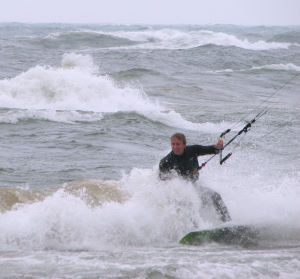5 Ways to Make Kiteboarding Easier
5 Ways to Make Kiteboarding Easier- From a Kiteboard Instructor
1. Get a wide/ flat board.
This will increase the planing ability and allow you to stay on top of the water with less power from the kite. It will also allow you to make better progress upwind. A bonus to going big to start is that you can keep this board for lightwind days after progressing to a high performance style of board.
2. Buy the right kite.
One of the greatest temptations of a beginner kiteboarder is to try out the sport "on the cheap" by buying old secondhand gear. While it is fine to have a budget, buying the wrong gear accomplishes nothing for you. If you are looking to "try it out" then take a lesson to help you decide if the investment is worth the reward (it always is in kiteboarding!).
The correct kite is one of the most important aspects of learning to kiteboard, so if you are not sure about what is right for you, call us at 1.800.622.4655 or speak with an instructor. Beginners are looking for a kite to cover winds under 20 knots. While the kite size varies for your weight, it will also vary depending on the kite design you choose.
As a beginner, your first kite should fit the following criteria...
- Sized for winds under 20 knots based on your weight
- Lots of depower in the bar throw
- At least 98% depower from the safety system. Most brands now have 100%
- Easy relaunch
- Stable flying- moves intentionally, not too responsive
- Move upwind easily
3. Make the drive for better conditions
 If there is smoother wind, a better wind direction, flatter water, fewer beachgoers, or just a nicer view, then make the drive. As a beginner, the conditions will often make or break your session. When I was first learning, I often made the mistake of going to the nearest beach for more time on the water. While that sounds good on paper, the reality is that often I was trying to learn in 3ft+ waves which make learning exponentially harder even for an experienced surfer. If I had made the extra 20min drive to the downwind jetty, I often would have found ideal glass flat water.
If there is smoother wind, a better wind direction, flatter water, fewer beachgoers, or just a nicer view, then make the drive. As a beginner, the conditions will often make or break your session. When I was first learning, I often made the mistake of going to the nearest beach for more time on the water. While that sounds good on paper, the reality is that often I was trying to learn in 3ft+ waves which make learning exponentially harder even for an experienced surfer. If I had made the extra 20min drive to the downwind jetty, I often would have found ideal glass flat water.
Keep an eye on the wind charts and forecasts; they will tell you where you want to go. Really- be looking for that 16-18 mph sideshore/ side-onshore wind as they are the best conditions for learning riding. This will be the sweet spot if you have found the correct first kite and are riding a larger board. Wind at this speed is manageable power for beginners but still has enough to ride without much kite finesse.
Another good reason to drive is for better wind conditions. If it is blowing a gusty 13 side offshore at my local spot, then I drive to a spot facing the wind more and will likely find sideshore or side onshore at 15-20 with smooth winds. A shorter session in good conditions will accomplish more and will most importantly be safer than the alternative.
4. Know what you are doing
Spend the extra time and money by taking a lesson and learning to fly. Kiteboarding is relatively safe these days due to the great kite design and safety systems offered. However, if you do not understand how to use them safely, they can become deadly to yourself or others. Learn to fly a trainer or a full size kite in very light winds before coming to a lesson if you can and it will allow you to get the most out of it. Lessons cannot be overlooked as they teach essential skills like self-rescue, safe launching/ landing of the kite, body dragging, board starts, how to rig, safety procedures, right of way, wind directions, wind quality, and much more. Taking lessons is cheaper than any ER visit, lawsuit, or kite replacement.
5. Have fun- slow things down
Kiteboarding is exciting and fun, but be sure to slow yourself down and double-check everything before launching. Keep your eyes open for obstacles, weather, and wind. Don't put yourself in a bad situation and always have a "what if ___ happens" plan.
